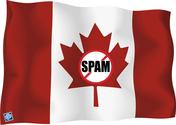- Posted on January 20, 2015
- in Blog, Email Marketing, LinkedIn
Don’t Get Caught - Canada Anti-Spam Legislation and LinkedIn
This post was first published on May 11 2014 and I updated it today, January 20 2015
On July 1, 2014 Canada’s Anti - Spam Legislation (CASL) went into effect and brought clarity about the definition of SPAM to Canadians . The considerable fines give it some teeth while some of the interpretations will probably keep a number of legal professionals busy for a while.
CASL brought the current laws closer to US standards and define what constitutes SPAM
One of the biggest changes is the inclusion of all electronic messages and not only email. It introduced the term “commercial electronic message’ CEM
CASL applies to a commercial electronic message (CEM) sent by any medium.
They don’t look at the sender, they look at the message, and it is technology neutral,” Ms. Babe of Miller Thomson says. “If you use social media to merely post an item, fine. If you use your LinkedIn, Facebook or Twitter account to send an e-mail to another person, which is commercial in nature, then it is a CEM under CASL.
In my words this means that any message that sent with the intent to sell something (including those by nonprofits and charities) fall under the new law.
As of July 1st all Social Media Marketing messages will have to conform to CASL even if they originate outside of Canada
CASL applies to most forms of electronic messaging, including email, SMS text messages, and certain forms of messages sent via social networking. Voice and fax messages are excluded, as they are covered by the Unsolicited Telecommunications Rules. The law applies broadly to any CEM that is sent from or accessed by a computer system located in Canada.
The second term we have to look at is “consent”
“CASL creates a permission-based regime, meaning that, subject to specific exclusions, consent is required before sending a CEM. Consent can either be express or implied.
In order to obtain express consent the sender must:
- clearly describe the purpose(s) for requesting consent;
- provide the name of the person seeking consent, and identify on whose behalf consent is sought, if different;
- provide contact information for either of those persons (mailing address and either a telephone number, email address of web address); and,
- indicate that the recipient can unsubscribe.
The CRTC has stated that, in its opinion, a pre-checked box cannot be used to obtain express consent.”
CASL provides that consent may be implied in any of the following four circumstances:
- the sender and recipient have an existing business relationship (e.g., the recipient has made a purchase within the past two years, or an inquiry within the past two months);
- the sender and recipient have an existing non-business relationship;
- the recipient has conspicuously published their electronic address(e.g., on a website), has not expressly stated that they do not wish to receive unsolicited messages, and the message is related to the recipient’s professional capacity; or,
- the recipient has disclosed their electronic address directly to the sender, has not expressly stated that they do not wish to receive unsolicited messages, and the message is related to the recipient’s business or official capacity.
~NNovation LLP
There is a lot of confusion about this right now and we will see how this can and will be enforced.
In my next CASL post I will go deeper into the impact of the law on email messages and your email list.
But for now let’s explore how CASL will effect the way we use LinkedIn and LinkedIn messages in particular.
- It is clear to me that LinkedIn messages fall under CASL in the same way as emails do
- It is my opinion that regular messages sent between 1st level connections can be seen as at least having “implied consent” because
- You have to agree to be connected to someone
- There is a clear process of severing a connection to someone
- InMail (LinkedIn’s internal messaging system) is a different story
- Agreeing to be connected on LinkedIn does not mean permission to send sales letters
- Members can opt out of receiving InMail but can not opt out of receiving messages from an individual
I hope that LinkedIn Canada will bring clarity in this matter soon. There is a period of two years where at least messages to your connections could be considered “implied consent” because a person agreed to be connected with you and therefore has a “business or personal relationship” with you.
LinkedIn needs to establish a clear way of obtaining “express consent”!
The Canadian Anti-Spam Legislation forces us to reevaluate the way we approach potential customers. As business people we have to spend more energy building relationships before we pitch a sale. I have to assume that most small business people don’t intentionally send out SPAM but we all have to re-think the definition of the term. Most of the time we think only about our intention and not how it is received on the other end.
As of July 1, 2014 CASL demands that all commercial electronic messages (CEM) sent to a computer in Canada require consent. This consent can be “implied” but have to be converted to “express consent” within 2 years.
How will CASL change the way you work?
Please let me know in the comments!Photo credit: licensed at depositphotos.com
Resources:
























